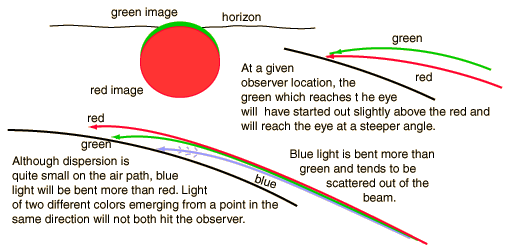Do you know anything about the "GREEN FLASH at SUNSET"?
Green Flash
The famous but seldom seen "green flash" or "emerald flash" which occurs just before the last part of the sun disappears from view at sunset is caused by the same atmospheric
refraction and
scattering effects which produce the
red sunset.
A rich subject for debate over the years, the green flash is rarely seen, but its observers wax eloquent about the brilliant green or emerald color when it is seen. In uniform air, the dispersion is apparently so small that the separation of red and green images is not visible. It takes more unusual layering of the atmosphere to enhance the separation.
Such a seldom seen and dramatic effect as the green flash tends to collect myth, so some care must be taken to separate fact from myth. I had reported from another reference that the perceived brilliance of the green might be heightened by the low-light enhancement of green vs the red end of the spectrum (see "
Rods do not see red!" in
color puzzles). Andrew Young contests this, stating that sunsets are so bright and provide so much light even in the green that significant bleaching of the pigment for both red and green may occur, certainly not the conditions for the
scotopic or low-light vision. Young maintains an excellent website of resources about green flashes, "
An Introduction to Green Flashes".
The index of refraction for red is 1.000292 and that for blue is 1.000295. Out of a total refraction of about 0.53°, the dispersion is only 0.006° or about 20 arc seconds, compared to a 120 arc sec resolution for the eye. Thus under normal conditions the eye would not see this.
Is that enough?

